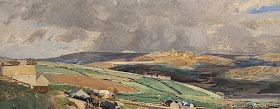Far from the beach, but still surrounded by treasure of all kinds just ready to be found, looked at, gloated over, gleaned and swiped or simply created! Here are my latest finds....
Monday, September 30, 2024
Retracing the Past and Present... Harold Harvey.
Sometimes what is the most glaringly self-evident in life nevertheless strikes me as strange and fascinating and so it is with the blindingly obvious idea that places that have meant so much in one lifetime (mine, as it happens!) have likewise had as much significance in those of others, throughout time. The experiences and emotions associated with a particular setting are joined by many more, over the years, decades and centuries. Places become shared repositories for the lives lived there, yet each set of memories largely independant and unaware of those before and after them, like strata set in ancient rock. Looking at the work of Cornish artist Harold Harvey (1874–1941) - on display at Penlee House Gallery & Museum, Penzance - in order to mark the 150th anniversary of his birth, I had the odd feeling of the familiar, seen through a prism - the eyes of an artist long-dead, and yet whose painted scenes are still recognisable today. The work above, The Marsh Landscape (1922), represents the lakes and marshland near Marazion, and remains uncannily similar today.
When travelling to what will always be home - even if it is no longer where I live - this precise part at the tail-end of the trip back marks the final stretch towards Penzance, as the train track runs parallel to the shoreline off Mount's Bay, offering glimpses of St Michael's Mount and then the town with Newlyn in the distance, as seen in this detail above of his Seaweed Gatherers (1904) and presumably in Collecting Seaweed of 1903.
Funny how I could not wait to board a train heading out of the county, all those years ago, eager to discover something new and therefore surely 'better', only to realise finally that the best was already there, all around me. Here is Harvey's 1907 painting, Return from the Orchard, with Newlyn harbour just distinguishable in the distance...
Harold Harvey, born in Penzance in 1874, would presumably have observed the trains departing too, however he knew that he did not wish to leave indefinitely. He chose to stay; depicting the Cornish coastal landscapes and the local fishermen, farmers and miners who inhabited these with their children, eking out a living for themselves, as their ancestors had done before them. Following his studies at Penzance School of Arts under Irish artist Norman Garstin (1847-1926), Harvey would spend almost his entire life, finally dying in Newlyn during the Second World War years. He did, however, leave Cornwall and indeed England for several years in his younger years in the 1890s, going to Paris to further his artistic training at the Académie Julian, in a manner similar to that of later painters from the Newlyn School of Art. On his return to Penzance, inspired by the artistic approach of Jules Bastien-Lepage (1848-1884), he painted plein-air in a style of naturalistic realism, working with his mentor Garstin, whilst influenced by the work of Stanhope Forbes (1857-1947) - known as the ‘father of the Newlyn School’. Below is Unloading the Catch, Newlyn Harbour from 1905.
By 1911, Harvey had met and married a fellow artist, Gertrude Bodinnar.(1879-1966) and settled in Newlyn, frequenting other members of the artistic community in Cornwall, including Alfred Munnings, Lamorna Birch and Laura Knight. Exempted from military service in the Great War due to health issues, Harvey remained in Cornwall.
Although wholeheartedly devoted to painting the everyday Cornish genre scenes around him, Harvey's style gradually changed to become lighter, sometimes impressionistic, employing simpler forms. During the war years, national security measures meant that painting local outdoor scenes became problematic, so that interior scenes of his beloved home and life there with his wife predominate his work from that period. His figurative painting evolved into a distinctive style that reflected a shared approach with his friends Ernest and Dod Proctor, and indeed the two men set up the Harvey-Procter School together in Newlyn in 1920.
Leaving the human interest of the paintings to one side, I took details of the paintings on display in the exhibition in order to 'feel' the essence of the countryside and seascapes beyond, without the elements that would indicate a set time in history. Such is the case with the section of Harvey's 1924 piece, The Road to Market, with its timeless sweeping moors and vast skies above. His works were exhibited several times in the Royal Academy in London, but Harvey never left his beloved Cornwall for the great city for any prolonged period.
Above is a small detail of the work Blackberrying 1917, with a dramatic view across the Bay with St Michael's Mount just visible, whilst the later painting, the Little Maiden (1934) offers an image down over Newlyn harbour from another high vantage point. Children often featured in Harvey's pieces, while he and Gertrude were apparently childless yet both came from very sizeable families, eight and ten respectively. I don't know if this weighed on them as a couple or gave them a feeling of weightlessness, with no direct bloodline stemming from them, to anchor their lives, secure in the perspective of future generations.
Perhaps this partly led Harold Harvey to convert to Catholicism in the latter years of his life; a spiritual journey not shared by his wife, but that is just speculation on my part. Home was certainly important to him and domestic scenes of his house and garden, generally featuring his wife, represent a significant proportion of an impressive artistic output, but of all of his art on display at Penlee House, the landscape details were my favourite....










No comments:
Post a Comment
Leave a message - please share your ideas!